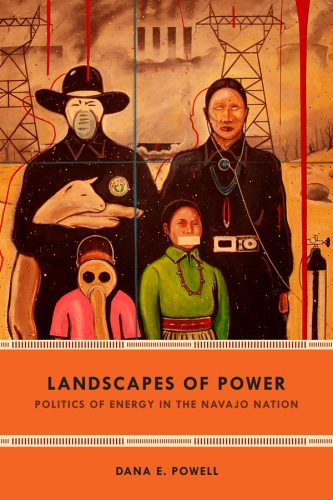In her monograph Landscapes of Power, Powell takes the proposed – at the time of her initial fieldwork – development project of the coal plant Desert Rock on Navajo land as an entry point into energy projects and their entanglement with issues of Indigenous sovereignty, power structures, and colonial history. At the turn of the millennium, Desert Rock was one of the most contested new energy developments in the US, and, even though it never materialized, it affected and changed different power relations.For Powell, the material absence of Desert Rock becomes an object of inquiry. She brilliantly shows not only how to research something that is not (yet) in existence, but also why it is important to do so.
 For her, the absence is generating, giving space to imaginations of the future, to alternative ways of knowing, and to hidden aspects of landscapes, power, and sovereignty. The absence of materiality does not mean that the projects do not exist. They exist as a reminder of the continuation of histories of extractions, displacements, and colonial abuse, and their meanings exceed their material impact.
For her, the absence is generating, giving space to imaginations of the future, to alternative ways of knowing, and to hidden aspects of landscapes, power, and sovereignty. The absence of materiality does not mean that the projects do not exist. They exist as a reminder of the continuation of histories of extractions, displacements, and colonial abuse, and their meanings exceed their material impact.
In my research, I am looking at a proposed quartz mine in the border region between Norway and Sweden. Although the mine has yet to materialize, it has already come into existence through imaginations, public discourse, and a long bureaucratic paper trail. Reading Powell’s work, I was struck by the many parallels between our two cases despite the different political, historical, and cultural contexts.
I will present some of these similarities to show how Powell’s locally rooted research is equally relevant internationally and how her concept of ‘four modalities of power’ is a useful tool for thinking through other cases of extraction.
About 20 years ago, ELKEM Salten applied for a mining concession in the mountainous region called Nasafjellet in Norway. The quartz mine would be situated in the middle of core reindeer herding ground for several Indigenous Sámi groups, an area through which up to 40 000 reindeer migrate on an annual basis.
Several environmental impact statements (EIS) were made, however both the applied methods and their findings were criticised as incomplete and in some parts biased. EIS evaluated the likely environmental impacts of proposed development projects including inter-related socio-economic, cultural and human-health impacts, both beneficial and adverse.
Powell follows the process of developing an EIS that – like the whole Desert Rock plant – never came into existence. EIS are written in bureaucratic language, assigning values to landscapes, fauna and flora, reindeer herding etc. In the report, the authors translate and summarise scientific knowledge into (for educated lay persons) more comprehensible language. Powell shows that the format of EIS does not allow for other ways of knowing than those of western science. In her example, the EIS fails in taking into account cultural specifics and Indigenous knowledge. Powell discusses how female Elders were ignored in the election of Indigenous “experts” and how knowledge transmission through narratives did not fit into the time schedule of community hearings.
This erasure shows overarching issues that commonly appear whenever natural resources are extracted on Indigenous lands: The hearings and information collection are designed in terms that favour knowledge and knowledge production that follow hegemonic European and North American academic traditions. Additionally, the imagined audience are readers that are familiar with technical language and used to long documents. Looking at which voices and knowledge are included exposes both structural hierarchies and ethnocentric assumptions as Powell shows throughout Chapter 4. Media and public discourse about extractive projects often display the same biases as EIS and lack a discussion of the historical, cultural, and societal complexity of industrial developments on Indigenous lands.
Both opponents and proponents of energy or extractive projects often base their argumentation (partly) on environmental reasoning. Indigenous opponents to proposed industrial projects are often equated to environmentalists in public discourse. While some might indeed identify themselves as such, this positioning erases the subjective commitments that for many are at stake, and especially issues of Indigenous sovereignty. Referring to Audra Simpson’s concept of refusal (2014), Powell argues that the refusal of Navajo citizens to be called environmentalists is an “affirmation of a way of being and knowing that is itself a collective commitment” (242 – 243). The dichotomy of being against or for industrial development projects is a false binary. As Powell shows, Indigenous nations are often divided about industrial projects. Working in extractive industries, claiming royalties, and advocating industrial developments on their land has the same roots as opposing them: working towards a good life for their nation and preserving Indigenous sovereignty.
In the case of the quartz mine, there was unity amongst Sámi organisations. When Sámi reindeer herders did further oppose the mining operation, ELKEM filed a motion in late 2017 to expropriate them. At the time of writing, the decision is still pending.
However, to understand the implications of ELKEM’s motion, the geographic positioning of the mine, the meaning of reindeer herding for Sámi cultures, and the history of forced displacements, livestock reductions, and assimilation politics need to be addressed.
Consequences of the expropriation would go far beyond the area in question, as the impact assessments also show. Transporting workers and mined materials, but also noise, dust, and necessary infrastructure will disturb reindeer herding grounds on a much larger scale than the mine alone and would presumably lead to a mixing of different herds, losing reindeers, reduced births, and in general animals in poorer conditions due to human induced stress. Livestock reduction can in the worst-case lead to the interruption of reindeer herding.
Relations to reindeers have been central to Sámi culture since time immemorial. From hunting reindeer to different forms of herding reindeer, Sámi people have tended relations to this species over several thousands of years. Coastal Sámi who did not engage in reindeer herding and had fishing and small-scale farming as their main subsistence activities were also included in these human-animal relations, as they participated in gift exchanges and trade interactions that involved reindeer meat and other material coming from the animal. Reindeer have also had a significant role in Sámi religion and spirituality prior to Christianisation. Reindeers and reindeer herding are therefore one of the most central symbols of Sámi cultural identity. Like sheep for the Navajo (Powell 2018, 45), reindeers are both companion species (Haraway 2003) and a source of life itself, giving nourishment, warmth, and wealth to their owners. The meaning of the expropriation would therefore by far exceed the local scale of lost land.
Imposed livestock reduction and forced displacement are recurring topics for many Indigenous nations worldwide. Powell describes the overpowering collective memory of terror, betrayal, loss and grief that is activated by discussions of resettling people and livestock in order to make space for industrial developments. She shows how both industry and governmental representatives do not consider the historical trauma of violent relocation and the repeated colonial targeting of sheep-holding as means of subduing Navajo resistance. In Scandinavia, shifting national borders and assimilation politics led to the displacement of many Sámi groups and to families losing their reindeer herds. Prominent cases of conflicts between individual reindeer herders and the Norwegian state show how these experiences are still ongoing, though in different ways.
Powell’s book is a call to observe and listen. Powell asks us as researchers to focus more on absences as objects of inquiries and shows us throughout the book both the importance of it and how one can do so. She also situates her work firmly in decolonial thought, mercilessly questioning her right to conduct research as a white anthropologist. It provides an instruction on how to research extractive projects on Indigenous lands. This makes her work highly relevant also beyond her topical or geographical focus.
Bibliography
Haraway, Donna. 2003. The Companion Species Manifesto. Chicago: Prickly Paradigm Press.
Simpson, Audra. 2014. Mohawk Interruptus. Political Life Across the Borders of Settler States.
Durham: Duke University Press.
Sweco AB 2013. Nasafjellet Kvartsforekomst. Konsekvensutredning – Virkninger for Miljø
og Samfunn. Revidert Utgave. Accessed 3.6.2020 at https://fido.nrk.no/43b9a824a1d92c8f409bf4dd7b40d0b6a206c615adc6bd064cb29c213f39166c/Konsekvensutredning%20Nasa%20Elkem.pdf.
Other reviews in this symposium:
Read Nimisha Thakur’s review here.
Read Susannah Crockford’s review here.
Featured Image by kasabubu, pixabay.com.



